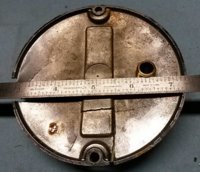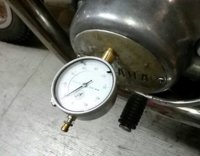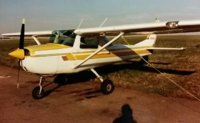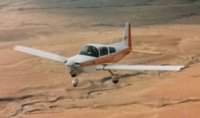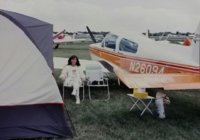So, investigating the brush forces and pressures, and researching commutator and slipring brush design engineering data.
GASP!! PamcoPete, you're right, this is a world unto itself.
Smoke's coming outta my ears. My head hurts.
I'll save you the excruciating mumbo-jumbo, and try to summarize.
The XS650 brushes measure 5mm x 4.5mm* (.195" x .175") in thickness/width, which makes a brush contact area of 0.225 sq-cm.
The resultant brush to slipring pressures of both new and old brushes comes out to:
NEW (370 grams-force) => 161.2 Kpa (23.4 Psi)
OLD (207 grams-force) => 90.2 Kpa (13.1 Psi)
The recommended brush pressures for a slipring applications are 17.5 Kpa to 20.0 Kpa (2.5 Psi to 2.9 Psi).
This closely matches the pressures listed on your linked .PDF file.
The upper limit for brush pressures is 225 Kpa (32.7 Psi). (cautioned, for extreme applications)
The brush performance tables I viewed don't even go past 75 Kpa (10.9 Psi).
Our XS650 spring pressures are almost 10 times higher than recommended.
The factory probably did this accomodate the XS's harsh vibrating environment and potential rotor irregularities, but this increases brush wear.
If the spring forces were to be relaxed to the recommended levels (about 40 - 46 grams), then vibration, surface irregularities, and rotor runout would definitely be a concern.
Kinda sounds like a 'Harley' solution is used here.
(If it breaks, make it bigger...)
GASP!! PamcoPete, you're right, this is a world unto itself.
Smoke's coming outta my ears. My head hurts.
I'll save you the excruciating mumbo-jumbo, and try to summarize.
The XS650 brushes measure 5mm x 4.5mm* (.195" x .175") in thickness/width, which makes a brush contact area of 0.225 sq-cm.
The resultant brush to slipring pressures of both new and old brushes comes out to:
NEW (370 grams-force) => 161.2 Kpa (23.4 Psi)
OLD (207 grams-force) => 90.2 Kpa (13.1 Psi)
The recommended brush pressures for a slipring applications are 17.5 Kpa to 20.0 Kpa (2.5 Psi to 2.9 Psi).
This closely matches the pressures listed on your linked .PDF file.
The upper limit for brush pressures is 225 Kpa (32.7 Psi). (cautioned, for extreme applications)
The brush performance tables I viewed don't even go past 75 Kpa (10.9 Psi).
Our XS650 spring pressures are almost 10 times higher than recommended.
The factory probably did this accomodate the XS's harsh vibrating environment and potential rotor irregularities, but this increases brush wear.
If the spring forces were to be relaxed to the recommended levels (about 40 - 46 grams), then vibration, surface irregularities, and rotor runout would definitely be a concern.
Kinda sounds like a 'Harley' solution is used here.
(If it breaks, make it bigger...)



 You have to wait for the brush to wear in so it is making a better cross sectional contact with the slip ring. This is also why it is important to re install your brushes with the same orientation.
You have to wait for the brush to wear in so it is making a better cross sectional contact with the slip ring. This is also why it is important to re install your brushes with the same orientation. 


